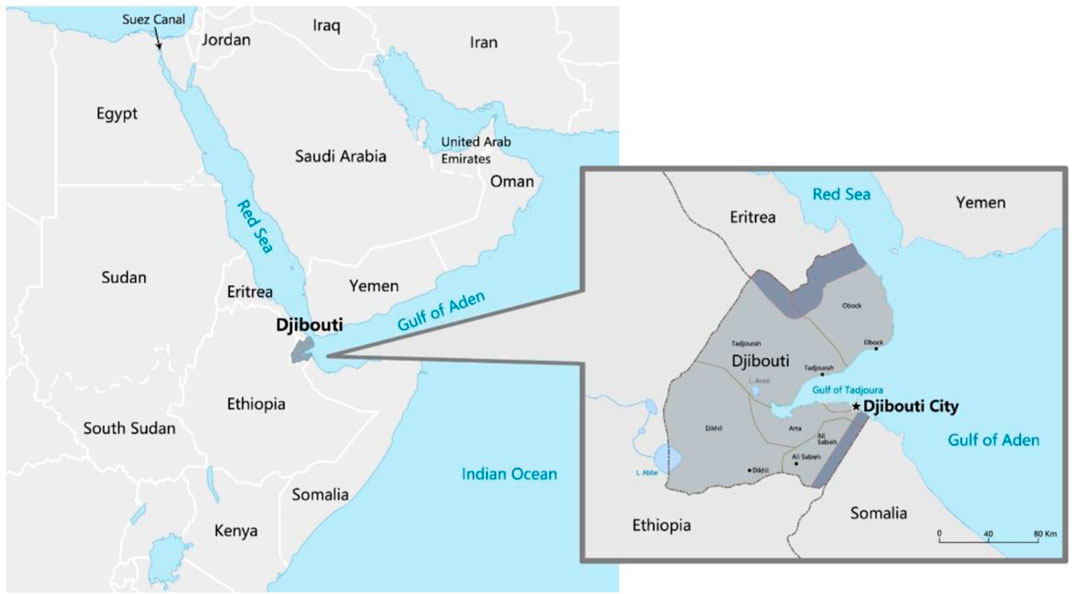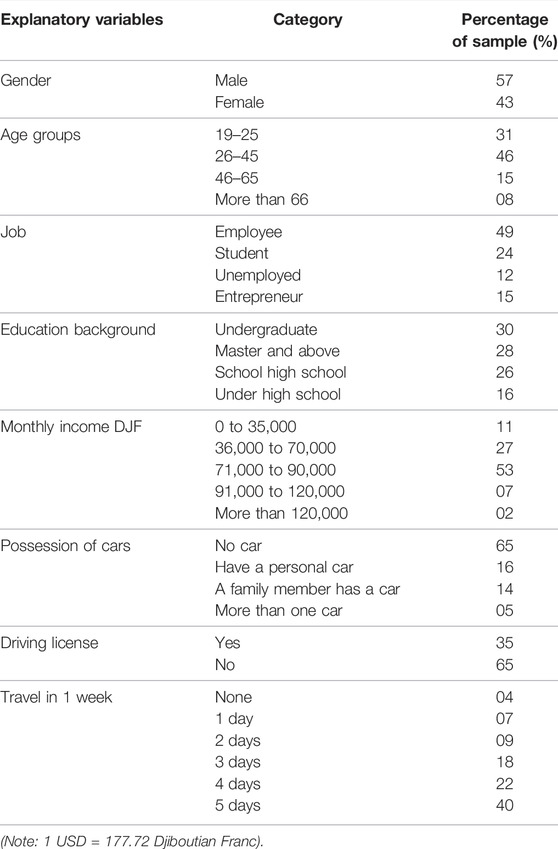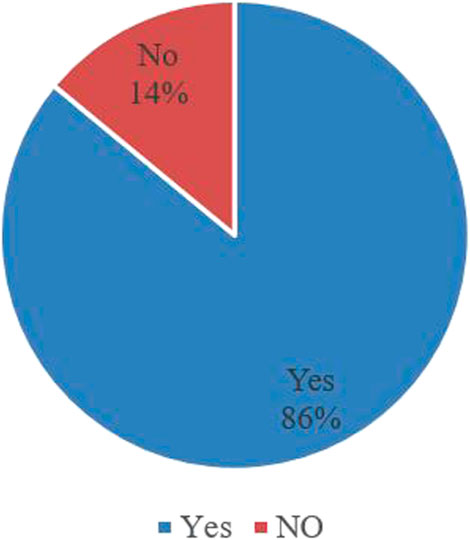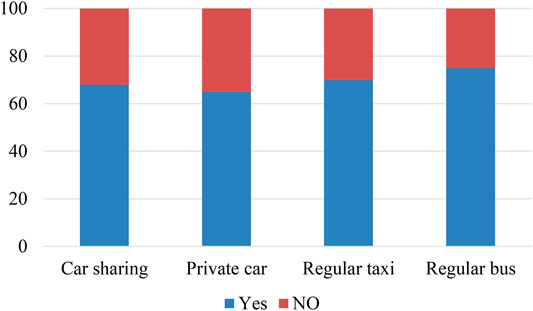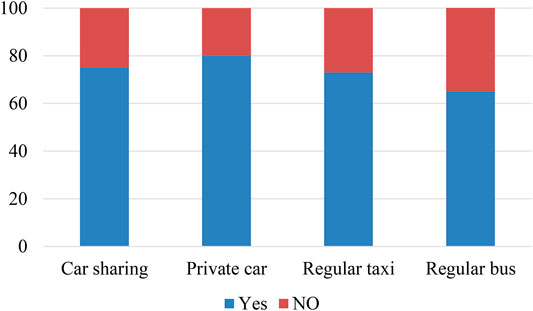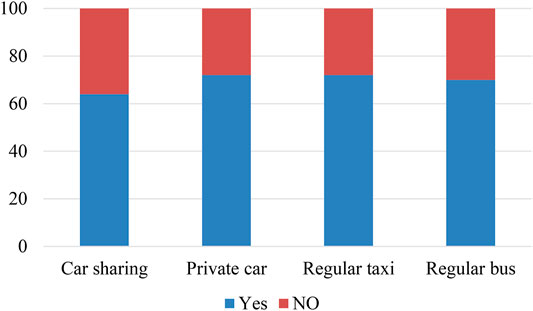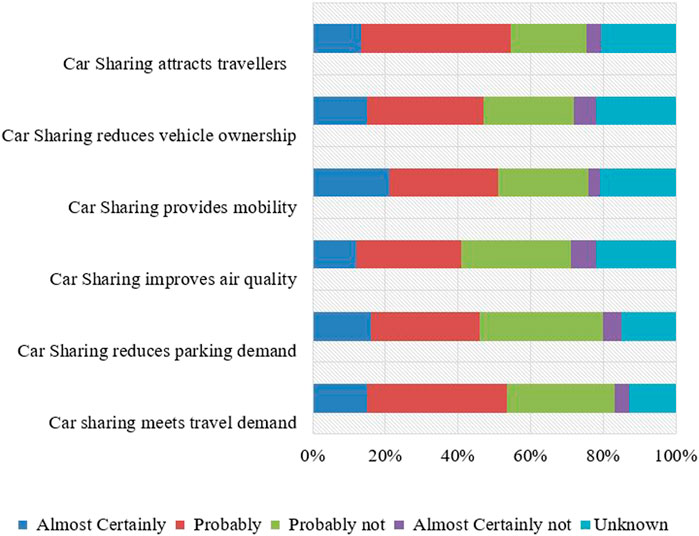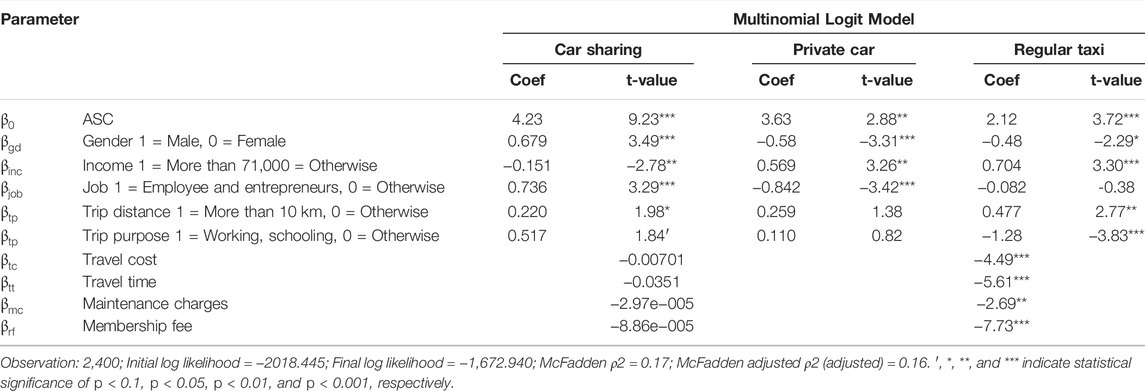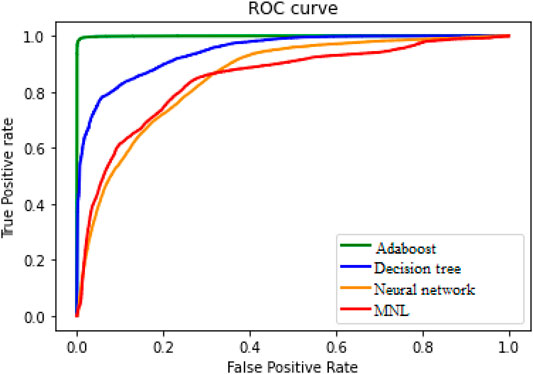- 1Transportation Engineering College, Dalian Maritime University, Dalian, China
- 2School of Transportation and Logistics, Dalian University of Technology, Dalian, China
- 3Department of Business and Administration, ILMA University, Karachi, Pakistan
- 4Intelligent Transportation Systems Research Center, Wuhan University of Technology, Wuhan, China
Transportation demand management is a successful complement to urban infrastructure. The emergence of shared mobility strategies such as car sharing offers sustainable mobility in urban areas. Car sharing has launched in different cities worldwide to mitigate severe transportation problems such as traffic congestion, air pollution, and traffic safety. Therefore, this study aims to investigate the intentions and preferences of travelers toward car sharing services in Djibouti, Africa. The data was collected through an online stated preference (SP) survey. The SP survey included the awareness of car sharing services, attributes related to transport modes, and demographic characteristics. A total of 600 respondents were received. In this study, we employed the multinomial logit (MNL) model to travel mode choice modeling and compared the results with the AdaBoost algorithm. The MNL model results showed that generic attributes such as travel time, travel cost, maintenance charges, and membership fees were found significant. In addition, several demographic characteristics like gender, education, and income were also found significant. The modeling and prediction performances of the MNL model and AdaBoost algorithm were compared using multi-class predictive errors. According to the goodness-of-fit results, the AdaBoost algorithm achieved overall higher prediction accuracy than the MNL model. This study could be helpful to transport planners and policymakers for the implementation of car-sharing services in urban areas.
1 Introduction
Urbanization and motorization have a significant impact on the viability of metropolitan areas in both developed and developing countries (Zhang et al., 2021; Safdar et al., 2022). The urban areas are becoming denser and more crowded than ever before. The rate of expanding existing road infrastructure is insufficient to meet the ever-increasing transportation demand (Jamal et al., 2020; Irfan and Ahmad 2021; Fang et al., 2022). Due to insufficient and inefficient public transport services, many individuals own private cars. Consequently, auto ownership increases, and posing a severe threat to transportation policymakers and other concerned authorities (Sun et al., 2021). Rapid motorization has several negative consequences, including increased travel time and cost, extreme congestion, increased safety issues, and polluted environment (Irfan et al., 2021a; Hao et al., 2021), rising fuel consumption (Irfan et al., 2022), and diminished transport system efficiency (Zhang et al., 2021). Consequently, the country’s economy has suffered a loss of millions of dollars (Ahmad et al., 2021; ELavarasan et al., 2021; Abbasi et al., 2022; Ahmad et al., 2022). Although an active and efficient transportation system is thought to boost the country’s economy, its effects on key urban areas must be explored first (Ali et al., 2021; Chandio et al., 2021; Tanveer et al., 2021; Irfan and Ahmad 2022).
Djibouti is a small country with an estimated 993,000 inhabitants, occupying the land of 23,200 km2. Djibouti is Sub-Saharan Africa’s most urbanized country, with approximately four-fifths of the population classified as urban. Although it is strategically located in sea transport linking Europe to the Middle East and Asia via the Red Sea, it is also geopolitically important as a gateway to inland East Africa, linking Africa and the Middle East coastal countries. Only by improving, investing, and designing the public transportation network will this be minimized. Djibouti’s road network consists of around 3,000 km of road. The capital’s primary routes include a paved road connecting Tadjoura and the north to the city, as well as the Grand Bara Road connecting the capital to the south. Mobility is primarily provided by an “informal” public transit system comprised of minibuses that circulate across the city, augmented with Bajaj and rickshaw vehicles that operate within Balbala. Only 4% of Djiboutians own cars; the remainder relies on public transportation. Green taxis are plentiful in Djibouti city and are a frequently used mode of travel across the city. Approximately 40% of Djiboutian residents appear to use public transportation regularly. This means that the remainder of the workforce must rely on walking, employer-provided transportation, or taxis.
Shared mobility and electrification are two significant developments in the evolution of transportation systems because they have the potential to deliver positive impacts in a variety of areas, including reducing traffic congestion by reducing single-occupancy private automobile journeys, lowering greenhouse gas emissions, and increasing accessibility and flexibility of mobility (Shaheen and Cohen, 2019; Irfan et al., 2021b). Shared mobility services integrate the two trends and may achieve synergy in terms of the anticipated positive benefits. It mostly consists of car sharing, e-bike sharing, and e-scooter sharing (Liao and Correia, 2020). Several companies and governments have launched full-scale shared e-mobility networks, and services are rapidly developing. To facilitate the market penetration of shared mobility, public authorities and shared mobility providers might benefit from additional information about their (future) customers and other travelers’ reactions to these services (such as existing usage patterns, consumer demand, and possible impacts) (Islam et al., 2022; Khan et al., 2021; Nuvvula et al., 2022).
The most popular mode of shared mobility is car sharing. Introduce a car sharing service in Djibouti to minimize automobile ownership and traffic congestion. In principle, the word “car sharing” is described as an option to car ownership; car sharing is a type of vehicle rental model in which users typically rent a vehicle for a while. To get and drive a sharing car, individuals must join a car sharing group and book the car using a smartphone app or the internet. Car sharing started in Europe in the 1940s before expanding to Australia, the Americas, and Asia (Shaheen et al., 2006). Following that, car sharing was established in Canada in the mid-1990s (Wang et al., 2012). Now car sharing has spread to more than 20 major urban areas in the United States and Canada. Car sharing had more than 378,000 members in July 2009, supported by 9,818 cars across North America (Shaheen and Cohen 2013). In North America, vehicle sharing systems frequently charge a monthly fee or deposit of $300 to $500, which is refundable. The consumption fee was computed based on time and kilometers, with $1.00 to $2.00 per hour and an extra $0.25 to $0.40 for each mile. These prices include fuel, insurance, and operating costs (Litman, 2000). Car sharing services attract people who generally use public transportation but need a car occasionally. Car sharing significantly reduces car ownership, resulting in less personal and street parking (Glotz-Richter, 2012; Alfian et al., 2015). In 2010, 26 nations implemented car sharing as a new form of transportation to lower auto transportation costs while decreasing adverse environmental effects such as congestion, energy consumption, and vehicle emissions (Martin et al., 2010; Rabbitt and Ghosh, 2013). Previous research indicates that vehicle sharing can decrease annual household GHG emissions to 0.58 metric tons from 0.84 metric tons (Rauf et al., 2021).
Car sharing “round trip” relinquishes between 9 and 13 automobiles off the road in North America (Martin et al., 2010). One of the most significant advantages of being a member of car sharing services is saving money on capital costs, maintenance costs, and parking fees. The burning of fossil fuels is deteriorating the environment (Razzaq et al., 2020,2021; Wu et al., 2021; Yang et al., 2021; Shi et al., 2022; Tang et al., 2022; Wen et al., 2022; Xiang et al., 2022), car sharing is expected to lower the pollution level. This enables consumers to use a “car sharing” service at a lower cost than owning a car (Ohta et al., 2013). In terms of societal impact, car sharing adds to more efficient and rational transportation by allowing people who do not own a personal vehicle to be flexible in using a car when needed (Baptista et al., 2015). Car sharing and driverless vehicles inspire substitute travel modes such as bike riding, walking and public transportation which not only reduce traffic congestion fewer parking requests but also enhance general public wellness in urban areas (Ullah et al., 2019a). Following the introduction of a car-sharing service in the country, 15 to 29 percent of Canadians sold their cars to take part in the service, whereas 11 to 26 percent of car sharing community members in the United States sold their private cars after joining this new service (Shaheen and Cohen 2013). Car sharing is now widely used in many large cities throughout the world, and it has provided numerous benefits in terms of social and environmental issues. Global car sharing is proliferating, with average yearly growth rates of members and vehicles of roughly 35% and 30%, respectively (Ullah et al., 2019b). In terms of passengers’ acceptance of car-sharing services, extant research has found that individuals and their connected circumstances significantly impact their willingness to join the system more than most car sharing qualities (Ciari and Axhausen 2012).
The majority of developing countries face traffic congestion and an absence of public transportation. Congestion is becoming more of a concern, impeding mobility and having negative economic and health consequences. Djibouti’s population is booming, and the city’s urban transportation network is becoming increasingly unsustainable and inadequate to the public demands. Car ownership will continue to rise in tandem with economic expansion, resulting in significant traffic and congestion in a compact, dense city, even as people who cannot afford car ownership will become further marginalized. Although, private car ownership is still low in Djibouti, public transit is outdated, inconvenient, and unaffordable for low- and middle-income residents. Public transportation is disproportionately expensive compared to city incomes, severely restricting residents’ access to travel and work, services, and other needs. The introduction of a car sharing service in Djibouti to provide equitable, efficient, and environmentally friendly modes of transportation, thereby addressing issues of inequalities in public transportation and traffic congestion.
This study has three objectives: first, to determine travelers’ preferences and attitudes toward car sharing service in Djibouti. Second, there is a scarcity of studies on transportation modes in Djibouti. Thus, this study fills this gap by thoroughly understanding transportation modes and introducing novel options such as car sharing. Third, car sharing is not yet accessible in Djibouti; therefore, this study used a stated preference survey and MNL models to evaluate travelers’ preferences towards a car sharing system. Further, we investigate the feasibility and capability of the AdaBoost algorithm to model discrete mode choice behaviors and compare their prediction performance with MNL.
2 Materials and Methods
2.1 Survey Design
In Djibouti, car sharing is not yet introduced; for collecting data on the unavailable alternative, the stated preference (SP) survey is used in this research. Many previous studies employed the SP survey to get data on travelers’ behavior and acceptability of vehicle sharing systems (Ullah et al., 2019b). In Pakistan, also electronic questionnaire was used through the Google Forms tool and distributed online. This study examines people’s attitudes and perceptions towards car sharing services, which were unavailable in Pakistan (Safdar et al., 2022). It was necessary to structure the questionnaire as an SP survey. Several factors are considered related to the traveler’s acceptance of car sharing service ‟ such as age, gender, car ownership, monthly income, as well as the various factors related to the service attributes, travel cost, travel time, membership fee, maintenance charges and so on. In this study, the SP survey comprised different parts; the first part provides a brief introduction to the concept of car sharing service to the travelers (Figure 1) and 2nd part is about awareness and perception about car sharing services. The following section comprises different service attributes (travel time, travel cost, membership fee, and maintenance charges). The last section comprised of social and demographic characteristics of the respondents: including gender, age, education level, job and monthly income. The alternative (transportation modes) and the level attributes are shown in Table 1. Figure 2 presents one of the choice experiments from the questionnaire.
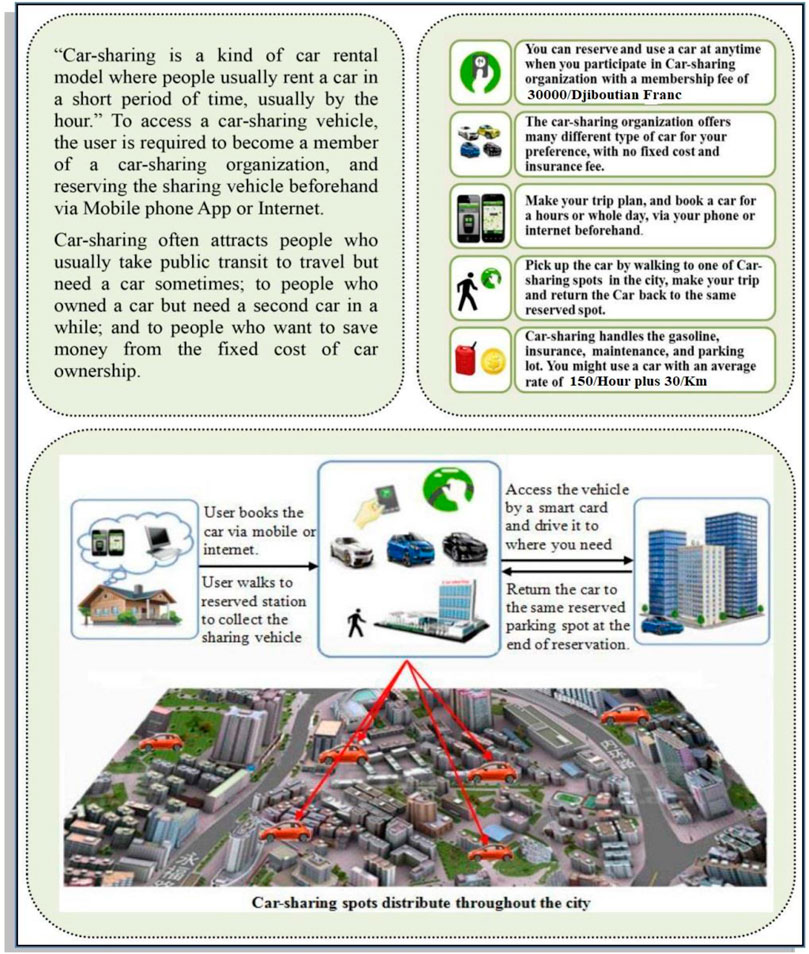
FIGURE 1. Car sharing brochure (Ullah et al., 2019b).
2.2 Data Collection
Djibouti is the capital city of Djibouti, and it is a tiny strategically positioned country on the Horn of Africa’s northeast coast. It is located on the Bab el Mandeb Strait, connecting the Red Sea to the Gulf of Aden to the east (Figure 3). Djibouti is a small country with an estimated 993,000 inhabitants that has experienced sustained growth which has pushed back the geographical boundaries of the city without the transport coverage adapting to these new contours. The bus routes established in 2006 for the center of Djibouti are no longer up to date and some new neighborhoods are not served. This is particularly the case for the new collective housing units in Balbala. In addition, routes considered unprofitable are not serviced by public transport. Existing services are unreliable due to the lack of fixed timetables, unmaintained vehicles, and routes that can change daily at the driver’s discretion. Moreover, even if the company’s profitability seems very low, the tariffs are considered high by users.
A growing population suffers from limited access to public transport services and employment. Poor transport conditions limit the mobility of women and children. In areas of the city where buses do not pass, households are forced to use the private car, although they find it difficult to bear the cost of these means of transport. With economic growth, the motorization rate of 4% of households will increase, leading to congestion in the already dense city. The share of the population that cannot afford a private car will be increasingly marginalized and their access to jobs and opportunities will be hampered by unreliable and expensive taxis. To collect the information about travelers’ acceptance of car-sharing services in Djibouti city, a questionnaire-based survey was conducted on a professional online Google Form platform. The questionnaires were designed for SP surveys and distributed online to the respondents. Questionnaires were divided into 3 groups. Each group has 4 different scenarios. Respondents were asked to complete the online questionnaire within 2 weeks after receiving it. The web-based survey had significant advantages; it is easy for people to complete the questionnaire in their free time without any hurdles.
Moreover, a well-designed framework of a survey website may help respondents fully understand the purpose of the survey and answer questions properly (Wang et al., 2017). The survey was completed in January 2022. Each group received 200 responses. Therefore, in three groups received a total of 600 respondents, which accumulated to 2,400 observations for the whole 12 scenarios.
The total respondents comprised 57% males and 43% females of the survey. The survey incorporated those people having age more than 18 years. Around 31% of the respondents comprised of age group between 19 and 25 years, and 46% were between the age of 26 and 45 years, and 15% of the respondents were between the age of 46 and 65 years, while 08% of the respondents were above 66 years of age. Furthermore, 49% of participants worked for public or private companies, while 12% were unemployed. However, 15% of the people who took the survey were entrepreneurs. The students constituted 24% of the total sample of participants. 28% of all respondents had a master’s degree or more, 30% had a bachelor’s degree, 26% had Matric level qualifications, and 16% had not completed high school. It was also found out that more than one-half of respondents had a household income that was in the middle-income range (71,000–90,000 DJF). Table 2 displays the socio-demographic characteristics of the respondents.
2.3 Car Sharing Awareness and Perception
After collecting data on socio-demographic characteristics of the respondents, questions were asked regarding car sharing awareness and familiarity of respondents. 86% of respondents are aware of car sharing services and 14% of respondents have no idea about car sharing services (Figure 4). In addition, Figures 5–7 present the findings of the respondents’ selection with different modes of transportation and trip purposes. According to Figure 5, respondents preferred car sharing services to personal cars for working trips. Similarly, respondents preferred taxis and buses for working trips as well. For shopping trips, respondents preferred private cars to car sharing services (Figure 6). Figure 7 shows the respondent’s preference for recreational trips.
Personal perceptions about the car sharing service are presented in Figure 8. It was observed that most of the respondents were aware of the car sharing service. As expected, more authors also assumed that people would be more likely to join car sharing if they were more familiar with the concept of car-sharing services (Fukuda et al., 2005).
3 Methodology
3.1 Discrete Choice Modeling
In transportation modeling, discrete choice models are widely utilized. It is easily interpretable since it can be derived from random utility theory. They do, however, rely on the modeler to describe the functional form of the observable component of the utility and to require the unobserved part to have a specified distribution. Its means that specification and estimation are typically done manually and entail multiple iterations.
3.1.1 Multinomial Logit Model
This study uses MNL to predict the public acceptance of car sharing services. In past studies for car sharing acceptance and behavioral response, various discrete choice models have been used. Such as the multinomial logit model, nested logit model, mixed logit model, and bivariate ordered probit model (Wang et al., 2012; Wang et al., 2021). The MNL model uses random utility maximization theory which states that individuals choose maximum utility alternatives. The total utility of MNL models consists of two parts: observable utility and random error components, which is presented by Eq. 1.
where, Uin represents the total utility of individual n; choosing alternative i, Xin represents the observable variables; βin represents the parameter vector, and εin represents the random error terms.
The general expression for the probability of choosing an alternative i (i = 1, 2, ... J) from a set of J alternatives is shown in Eq. 2.
Where
The structure of the MNL model describes each choice alternative through a utility function as follows.
Car sharing:
Private car:
Regular taxi:
Regular bus:
3.2 Machine Learning Models
We employed various ML models. Recent research into using ML models to travel mode choice modeling has demonstrated its virtues, and most known studies that compare ML models to statistical models imply ML models could reach equivalent or even higher prediction accuracy (Wang and Ross, 2018). Most ML models do not require strict statistical assumptions, allowing them to be applied to a wide range of data structures. ML models have grown in popularity due to their capacity to capture non-linear correlations between variables and fewer model assumptions, allowing them to predict superiority in various fields (Ullah et al., 2021a). Some ML techniques, such as ensemble methods (Adaboost), have been found to help weak learners, such as low-depth decision tree models, increase prediction accuracy. In this study, all ML models are developed using the orange data mining toolbox in python. In addition, the Orange toolbox in python provides a complete variety of methods for data pre-processing and modeling used for data preparation.
3.2.1 AdaBoost
AdaBoost is an ensemble technique that aims to create a robust classifier from a collection of weak ones. This is accomplished by first creating a model from the training data then attempting to correct the errors in the first model with a second model. Models are added until the training set is perfectly predicted or until the maximum number of models has been reached. The multi-class exponential function algorithm (SAMME.R) and a linear loss function were employed in stagewise additive modeling. The learning rate and the number of estimators are 1 and 100, respectively.
3.2.2 Neural Network
Neural networks are made up of repeated layers of interconnected activation nodes, also known as neurons. The transformation of input features through hidden layers allows for effectively modeling complex interaction effects and structure. The weights in each layer are trained using gradient descent and the backpropagation algorithm. Adam solver was used, the maximum number of iterations are 200, and the neurons in hidden layers are 100.
3.2.3 Decision Tree
Decision tree is used to make a classification or regression model in the form of a tree structure. This tool breaks down the data set into smaller parts simultaneously as it makes the whole thing smaller. The corresponding decision tree is built up gradually. A decision tree is a tree data structure with a random number of branches, nodes, and leaves at each node. The internal nodes are being used to classify examples for classification or regression purposes. The input variable’s value serves a specific function (Ullah et al., 2021b). In decision tree, the number of nodes and leaves are 9,563 and 4,782, and the tree depth is 15.
4 Results and Discussion
4.1 MNL Result
The current study used the MNL model to estimate collected stated preference data. MNL model parameter coefficient was estimated using the maximum likelihood function method through Biogeme software. This study employed the MNL model for available four modes of transport as car sharing, private car, regular taxi and regular bus. The MNL has the advantage because the variable parameters are easily interpretable and can overcome bias if all the relevant variables are input in the model. The relevant variables were put in a stepwise manner for achieving a better fit of the model. Also, the insignificant variables were removed from the final model. The regular bus was taken as the reference alternative in the estimation process. The model estimation results are given in Table 3. The MNL model achieved acceptable performance.
The alternative specific constant is higher for car sharing among the other alternatives, which reveals that this mode has higher utility relative to others. All the generic variables (travel time, travel cost, membership fees, and maintenance charges) have the expected signs and are highly significant. These results indicated that the Djibouti people are more willing to use those transport modes having minimum fares, less travel time, and fewer membership fees of the fleet. This result is aligned with a study conducted in Pakistan to evaluate car sharing system in Pakistan (Ullah et al., 2019b). This result is plausible in Djibouti, where mostly people use shared taxis or rental cars. It is expected that Djiboutians would be switched to car sharing when it is practically viable in the city.
Males are more likely to be attracted to car sharing and regular taxi modes than having a vehicle, as indicated by the gender-specific high parameter value for car sharing. This result is self-evident: car sharing offers the same benefits as owning a private car without the associated costs. In Djibouti, males had higher proportions of driver’s licenses than females. This may be explained by the fact that most Djiboutians finance or rent their private vehicles. Thus, car sharing is free of these external costs, with the user paying only per kilometer or hour traveled. On the other hand, females were more likely to opt for a private car. In Djibouti, just 4% of the population has a private car, and only the wealthy and elite use them. Additionally, females in Djibouti were more inclined to rent a taxi for their travels because private cars are costly for those with middle- or low-income people. At the given significance level, this gender has a significant relationship with the response variable. Females are slightly more likely to join car sharing programs in North America and Europe (De Luca and Di Pace 2014; Giesel and Nobis 2016).
Age and education were insignificant and were therefore excluded from the final models. Employment had a significant impact on the decision to use car sharing. Employed individuals, both business owners and employees, were more likely to use car sharing services. This outcome is expected, as most employed individuals are stressed out by daily commuting due to scarce public transit that lacks a regular schedule and is monopolized. Another report (Djibouti Technical Assistance for Urban Public Transport, 2019) indicates that the people of Djibouti were highly concerned about waiting times, comfort, driving behavior, and safety. These issues can be resolved by implementing a car sharing system in Djibouti. Employed people in Djibouti cannot afford the purchase and other costs associated with personal cars.
Additionally, employees and business people were more inclined to travel by private car. Regarding the income variable, lower-income individuals were more inclined to car sharing. This finding is intuitive, given how frequently lower- and middle-income residents of Djibouti use public transportation. This demonstrates that individuals prefer car sharing. This finding is particularly relevant in developing countries, where the fragmented and inefficient transportation system. Moreover, income was positively and strongly associated with private cars. Individuals with a high income prefer to drive their cars (Kato et al., 2013). This is since high-income people usually have a driver for driving them to work or other purposes. With car sharing, they will be able to save the surplus cost and will use their time on some necessary errands. The trip distance was significant for car sharing and taxis. The travelers chose car sharing for the trip distance of more than 10 km. This result is feasible in Djibouti since the activity is concentrated in sprawling areas. The majority of individuals rely on public transportation and taxis. The walking, rickshaw, and motorcycle were used to make the short distances less than 3 km. This finding in-line with the report (Djibouti Technical Assistance for Urban Public Transport, 2019) that Djiboutians travel 4% by automobile, 40% by public transit and the remainder by foot or rickshaw.
The trip purpose variable was found significant for car sharing. This shows that people who commute to work and school were prone to use car sharing. On the other hand, people who traveled to social activity mostly used taxis. This could be explained that the private car ratio is limited and mostly people use shared taxi and public transport. This could be improved by providing car sharing system to eliminate the inequity issue.
4.2 Models Comparison
The prediction performance of the models is summarized in Table 4 utilizing different classification evaluation metrics, including accuracy, F1, precision, and Recall. Accuracy shows the proportion of correctly classified samples to the entire sample. The AdaBoost produced outperformed accuracy (0.90). MNL obtained the lowest accuracy (0.68). Similarly, when all other evaluation metrics were considered, AdaBoost predictive performance is superior.
Figure 9 shows the model’s predictive performance regarding the relevant confusion matrices for each classification model. The confusion matrices in Figure 9 depict the disparity between predicted and actual observations for individual transportation modes in the data set. In Table, each row in the matrix reflects the actual number of observations for a specific mode, while the columns represent the predicted number of observations for a specific mode. The values of the cells across the diagonal represent accurate predictions, whereas the cells off the diagonal represent misclassifications that result in an over or underestimate of the model. The AdaBoost model outperformed other models. The Adaboost model correctly classifies instances are 437 and 235 incorrectly classifies instances for car sharing mode. Similarly, for the private car mode, the correctly classified instances are 700, and the incorrectly classified instances are 265. For regular bus mode, the correctly and incorrectly classified instances are 192 and 183, respectively. Considering the regular taxi mode, the correctly classified instances are 236 and the incorrectly classified instance are 152. Confusion matrices generated by decision trees, neural networks, and MNL can be interpreted similarly.
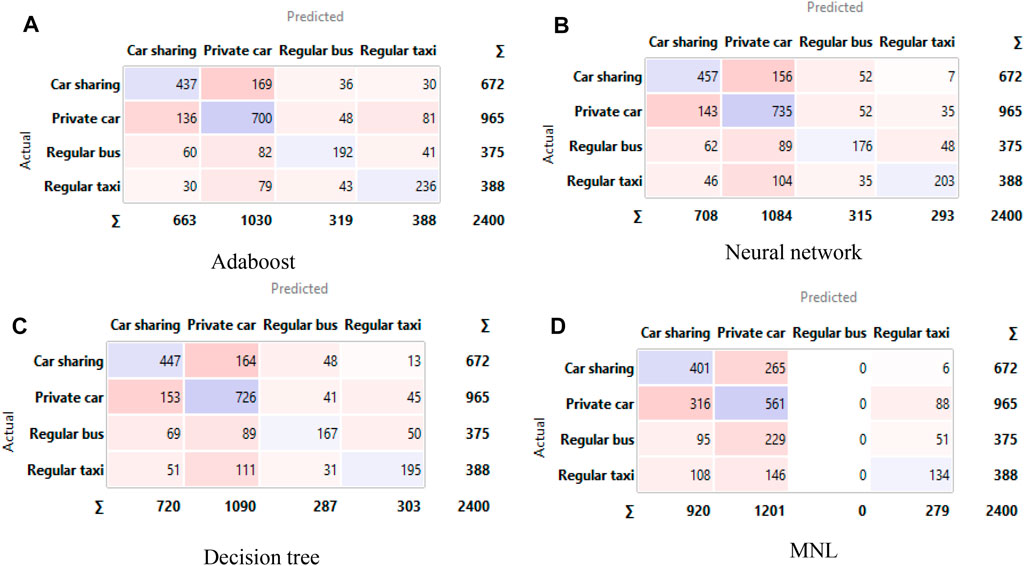
FIGURE 9. Confusion matrix generated for the different transportation mode. (A) Adaboost (B) Neural network (C) Decision tree (D) MNL.
In this paper, receiver operating characteristic (ROC) is plotted as a better metric to represent model performance. The ROC curve and area under the curve (AUC) metrics used to evaluate the predictive performance of the proposed models against transportation modes are shown in Figure 10. In ROC curves, the true positive rate is commonly plotted on the Y-axis, while the false positive rate is plotted on the X-axis. This implies that the “ideal” point is in the upper left corner of the Figure, with a false positive rate of 0 and a true positive rate of 1. The “steepness” of ROC curves is also essential since it is ideal for maximizing true positive rate while reducing false positive rate. The AUC is the area enclosed by the ROC curve, with a maximum value of 1, signifying a perfect classification result. As shown in Figure 10, the Adaboost AUC value is 1 for all the classes. The decision tree, neural network, and MNL AUC value are more than 0.80 for all the classes. Further, the model’s comparison by ROC and AUC metrics is shown in Figure 11. The Adaboost model achieves the best performance than others, as seen in Figure 11. According to the results, all the models were robust in predicting charging class within a given data set. Nevertheless, Adaboost had superior prediction performance.
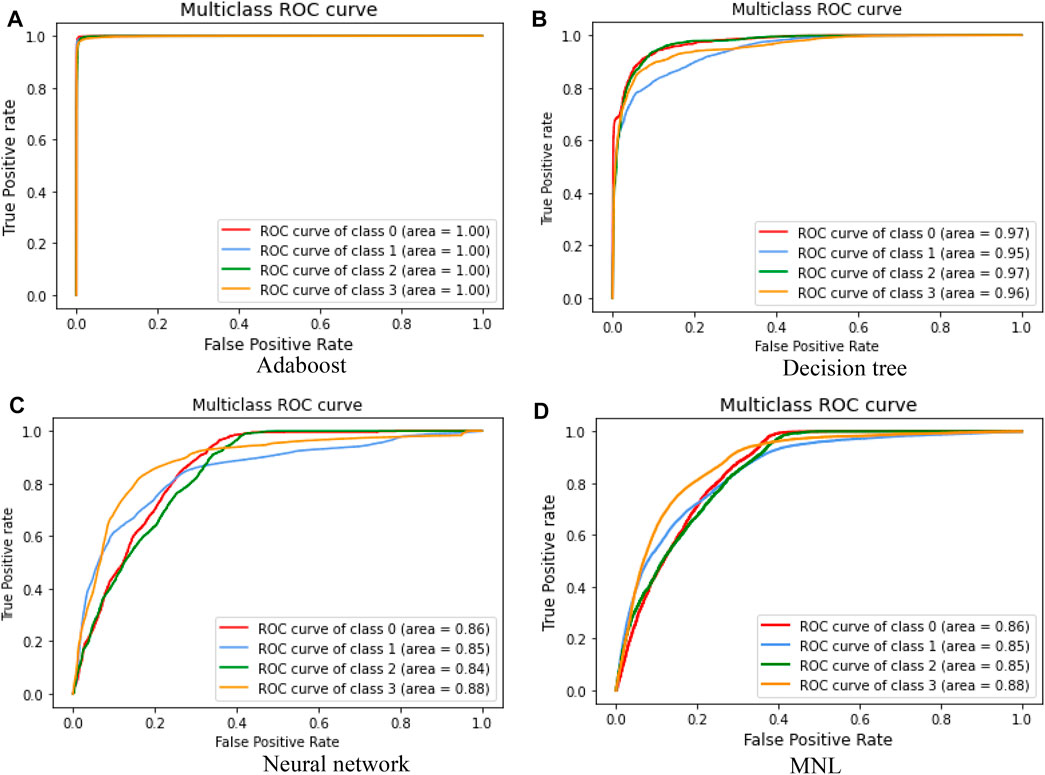
FIGURE 10. ROC curve for different models and different classes. Class 0 (Car sharing): Class 1 (Private car): Class 2 (Regular bus): Class 3 (regulat taxi). (A) Adaboost (B) Decision tree (C) Neural network (D) MNL.
5 Conclusion
The objective of this study was to investigate the traveler preferences and attitude towards car sharing system in Djibouti, Africa. Car sharing service was not available yet in the city of Djibouti, therefore the study adopted stated preference survey to collect data about perceptions, attitudes and mode choice scenarios. The study has employed MNL and ML models including Adaboost, Decision tree, Neural network for analysis and prediction. According to the goodness-of-fit results, the AdaBoost algorithm achieved overall higher prediction accuracy than the MNL model and others. The obtained results showed that the entire proposed model’s predictive accuracy is acceptable for all the transportation modes. Nevertheless, AdaBoost had superior prediction performance. The causes and incentives for developing a car sharing service have been highlighted, as well as the significance of individual behavior in selecting concepts. Many factors significantly affect the decision-making process concerning different types of services. The research also tried to determine whether car sharing could control the growth of private cars, which has become a significant concern in Djibouti in recent years.
This research contributes some valuable insights from a Djibouti city in an underdeveloped nation. In discrete choice, modeling the MNL has been revealed the significant factors which affect travelers ‟acceptance of car sharing services. Several demographic variables were identified as the main factors affecting the acceptance of car sharing services. The findings show gender, employment, and income had a significant impact on travelers’ acceptance of the car sharing service. While some situational factors such as trip distance, and trip purpose were also perceived as significant attributes. This study revealed that people who travel distance of more 10 km or more than 10 km were highly prone to use car sharing in a developing country. This result is somewhat difference from developed countries where people used it for short distances. Similarly, generic variables such as travel cost, travel time, and membership fee were also highly significant with car sharing. This study revealed that car sharing would decrease car ownership.
According to the study’s findings, additional research on specific groups such as gender, employment, and income is necessary to acquire meaningful results. Additionally, various business models must be considered prior to the effective deployment of a car sharing program in Djibouti. To analyze public acceptance and preferences of car sharing, structural equation modeling and hybrid discrete choice are recommended. Similarly, the sample size of the survey might be increased to get greater confidence in the collected results. Car sharing is a relatively new concept in Djibouti, and public awareness is minimal. Considering respondents who did not respond to the online survey to be biased.
The COVID-19 has a serious influence on travelers’ attitudes on modes of transportation, particularly shared modes of transport, on a global level. However, the COVID-19 pandemic is not yet over, and car sharing studies should be undertaken both during and after the COVID-19 pandemic to develop a comprehensive strategy. The study’s conclusions are also applicable to other developing countries’ urban areas with similar demographic and socioeconomic characteristics. It would be fascinating to explore alternative car sharing models such as one-way, peer-to-peer, and free-floating to determine which can be implemented more successfully. Additionally, electric car sharing is gaining popularity as a new area of study for tackling environmental challenges. To achieve greater accuracy, accomplishment will use these standards into future investigations. Planners can help the car sharing service grow and spread across the country, which will improve people’s lives and speed up the transition to more environmentally friendly transportation in the future. Future research should concentrate on various approaches that can effectively encourage car sharing in Djibouti.
Data Availability Statement
The original contributions presented in the study are included in the article/Supplementary Material, further inquiries can be directed to the corresponding author.
Author Contributions
WA: questionnaire Design, Data collection, Writing original draft IU: questionnaire Design, Methodology; Writing original draft MS: Methodology; Writing original draft JZ: questionnaire Design, review and editing original draft.
Funding
This paper is partly supported by National Natural Foundation Science of China (71871036, 72031005, 71831002).
Conflict of Interest
The authors declare that the research was conducted in the absence of any commercial or financial relationships that could be construed as a potential conflict of interest.
Publisher’s Note
All claims expressed in this article are solely those of the authors and do not necessarily represent those of their affiliated organizations, or those of the publisher, the editors and the reviewers. Any product that may be evaluated in this article, or claim that may be made by its manufacturer, is not guaranteed or endorsed by the publisher.
References
Abbasi, K. R., Shahbaz, M., Zhang, J., Irfan, M., and Alvarado, R. (2022). Analyze the Environmental Sustainability Factors of China: The Role of Fossil Fuel Energy and Renewable Energy. Renew. Energ. 187, 390–402. doi:10.1016/j.renene.2022.01.066
Ahmad, B., Da, L., Asif, M. H., Irfan, M., Ali, S., and Akbar, M. I. U. D. (2021). Understanding the Antecedents and Consequences of Service-Sales Ambidexterity: a Motivation-Opportunity-Ability (MOA) Framework. Sustainability 13 (17), 9675. doi:10.3390/su13179675
Ahmad, B., Irfan, M., Salem, S., and Asif, M. H. (2022). Energy Efficiency in the Post-COVID-19 Era: Exploring the Determinants of Energy-Saving Intentions and Behaviors. Front. Energ. Res. 9, 824318. doi:10.3389/fenrg.2021.824318
Alfian, G., Rhee, J., Kang, Y.-S., and Yoon, B. (2015). Performance Comparison of Reservation Based and Instant Access One-Way Car Sharing Service through Discrete Event Simulation. Sustainability 7, 12465–12489. doi:10.3390/su70912465
Ali, S., Yan, Q., Sajjad Hussain, M., Irfan, M., Ahmad, M., Razzaq, A., Dagar, V., and Işık, C. (2021). Evaluating Green Technology Strategies for the Sustainable Development of Solar Power Projects: Evidence from Pakistan. Sustainability 13 (23), 12997. doi:10.3390/su132312997
Baptista, P., Pina, A., Duarte, G., Rolim, C., Pereira, G., Silva, C., et al. (2015). From On-Road Trial Evaluation of Electric and Conventional Bicycles to Comparison with Other Urban Transport Modes: Case Study in the City of Lisbon, Portugal. Energ. Convers. Manag. 92, 10–18. doi:10.1016/j.enconman.2014.12.043
Chandio, A. A., Jiang, Y., Akram, W., Adeel, S., Irfan, M., and Jan, I. (2021). Addressing the Effect of Climate Change in the Framework of Financial and Technological Development on Cereal Production in Pakistan. J. Clean. Prod. 288, 125637. doi:10.1016/j.jclepro.2020.125637
Ciari, F., and Axhausen, K. W. (2012). “Choosing Carpooling or Car Sharing as a Mode: Swiss Stated Choice Experiments,” in Proceedings of the 91st Annual Meeting of the Transportation Research Board (TRB 2012) (Washington, DC: Transportation Research Board (TRB)), 12–4205.
De Luca, S., and Di Pace, R. (2014). Modelling the Propensity in Adhering to a Carsharing System: A Behavioral Approach. Transportation Res. Proced. 3, 866–875. doi:10.1016/j.trpro.2014.10.065
Djibouti Technical Assistance for Urban Public Transport (2019). Situational Analysis DRAFT 5 – December 2019
Elavarasan, R. M., Pugazhendhi, R., Shafiullah, G. M., Irfan, M., and Anvari-Moghaddam, A. (2021). A Hover View over Effectual Approaches on Pandemic Management for Sustainable Cities - the Endowment of Prospective Technologies with Revitalization Strategies. Sust. Cities Soc. 68, 102789. doi:10.1016/j.scs.2021.102789
Fang, Z., Razzaq, A., Mohsin, M., and Irfan, M. (2022). Spatial Spillovers and Threshold Effects of Internet Development and Entrepreneurship on green Innovation Efficiency in China. Tech. Soc. 68, 101844. doi:10.1016/j.techsoc.2021.101844
Fukuda, T., Kashima, S., Fukuda, A., and Narupiti, S. (2005). Analysis of Car Sharing Application on Consumer Orientation and Their Modal Selection in Bangkok. J. East. Asia Soc. Transportation Stud. 6, 1971–1986.
Giesel, F., and Nobis, C. (2016). The Impact of Carsharing on Car Ownership in German Cities. Transportation Res. Proced. 19, 215–224. doi:10.1016/j.trpro.2016.12.082
Glotz-Richter, M. (2012). Car-Car-Sharing - "Car-On-Call" for Reclaiming Street Space. Proced. - Soc. Behav. Sci. 48, 1454–1463. doi:10.1016/j.sbspro.2012.06.1121
Hao, Y., Gai, Z., Yan, G., Wu, H., and Irfan, M. (2021). The Spatial Spillover Effect and Nonlinear Relationship Analysis between Environmental Decentralization, Government Corruption and Air Pollution: Evidence from China. Sci. Total Environ. 763, 144183. doi:10.1016/j.scitotenv.2020.144183
Irfan, M., and Ahmad, M. (2022). Modeling Consumers' Information Acquisition and 5G Technology Utilization: Is Personality Relevant? Personal. Individual Differences 188, 111450. doi:10.1016/j.paid.2021.111450
Irfan, M., and Ahmad, M. (2021). Relating Consumers' Information and Willingness to Buy Electric Vehicles: Does Personality Matter? Transportation Res. D: Transport Environ. 100, 103049. doi:10.1016/j.trd.2021.103049
Irfan, M., Elavarasan, R. M., Ahmad, M., Mohsin, M., Dagar, V., and Hao, Y. (2022). Prioritizing and Overcoming Biomass Energy Barriers: Application of AHP and G-TOPSIS Approaches. Technol. Forecast. Soc. Change 177, 121524. doi:10.1016/j.techfore.2022.121524
Irfan, M., Elavarasan, R. M., Hao, Y., Feng, M., and Sailan, D. (2021a). An Assessment of Consumers' Willingness to Utilize Solar Energy in China: End-Users' Perspective. J. Clean. Prod. 292, 126008. doi:10.1016/j.jclepro.2021.126008
Irfan, M., Hao, Y., Ikram, M., Wu, H., Akram, R., and Rauf, A. (2021b). Assessment of the Public Acceptance and Utilization of Renewable Energy in Pakistan. Sustainable Prod. Consumption 27, 312–324. doi:10.1016/j.spc.2020.10.031
Islam, M. M., Irfan, M., Shahbaz, M., and Vo, X. V. (2022). Renewable and Non-renewable Energy Consumption in Bangladesh: the Relative Influencing Profiles of Economic Factors, Urbanization, Physical Infrastructure and Institutional Quality. Renew. Energ. 184, 1130–1149. doi:10.1016/j.renene.2021.12.020
Jamal, A., Tauhidur Rahman, M., Al-Ahmadi, H. M., Ullah, I., and Zahid, M. (2020). Intelligent Intersection Control for Delay Optimization: Using Meta-Heuristic Search Algorithms. Sustainability 125, 1896. doi:10.3390/su12051896
Kato, H., Inagi, A., and Igo, T. (2013). Potential Choices of Travel Mode Including Carsharing and Carsharing Membership: Evidences from Four Japanese Cities. J. East. Asia Soc. Transportation Stud. 10, 630–646.
Khan, I., Hou, F., Irfan, M., Zakari, A., and Le, H. P. (2021). Does Energy Trilemma a Driver of Economic Growth? the Roles of Energy Use, Population Growth, and Financial Development. Renew. Sust. Energ. Rev. 146, 111157. doi:10.1016/j.rser.2021.111157
Liao, F., and Correia, G. (2020). Electric Carsharing and Micromobility: A Literature Review on Their Usage Pattern, Demand, and Potential Impacts. Int. J. Sust. Transportation, 1–30. doi:10.1080/15568318.2020.1861394
Litman, T. (2000). Evaluating Carsharing Benefits. Transportation Res. Rec. 1702, 31–35. doi:10.3141/1702-04
Martin, E., Shaheen, S. A., and Lidicker, J. (2010). Impact of Carsharing on Household Vehicle Holdings. Transportation Res. Rec. 2143, 150–158. doi:10.3141/2143-19
Ohta, H., Fujii, S., Nishimura, Y., and Kozuka, M. (2013). Analysis of the Acceptance of Carsharing and Eco-Cars in Japan. Int. J. Sust. Transportation 7, 449–467. doi:10.1080/15568318.2012.688092
Rabbitt, N., and Ghosh, B. (2013). A Study of Feasibility and Potential Benefits of Organised Car Sharing in Ireland. Transportation Res. Part D: Transport Environ. 25, 49–58. doi:10.1016/j.trd.2013.07.004
Razzaq, A., Ajaz, T., Li, J. C., Irfan, M., and Suksatan, W. (2021). Investigating the Asymmetric Linkages between Infrastructure Development, green Innovation, and Consumption-Based Material Footprint: Novel Empirical Estimations from Highly Resource-Consuming Economies. Resour. Pol. 74, 102302. doi:10.1016/j.resourpol.2021.102302
Razzaq, A., Sharif, A., Aziz, N., Irfan, M., and Jermsittiparsert, K. (2020). Asymmetric Link between Environmental Pollution and COVID-19 in the Top Ten Affected States of US: A Novel Estimations from Quantile-On-Quantile Approach. Environ. Res. 191, 110189. doi:10.1016/j.envres.2020.110189
Safdar, M., Jamal, A., Al-Ahmadi, H. M., Rahman, M. T., and Almoshaogeh, M. (2022). Analysis of the Influential Factors towards Adoption of Car-Sharing: A Case Study of a Megacity in a Developing Country. Sustainability 14, 2778. doi:10.3390/su14052778
Shaheen, S. A., and Cohen, A. P. (2013). Carsharing and Personal Vehicle Services: Worldwide Market Developments and Emerging Trends. Int. J. Sustain. transportation 7, 5–34. doi:10.1080/15568318.2012.660103
Shaheen, S. A., Cohen, A. P., and Roberts, J. D. (20061986). Carsharing in North America. Transportation Res. Rec. 1986, 116–124. doi:10.1177/0361198106198600115
Shaheen, S., and Cohen, A. Shared Micromoblity Policy Toolkit: Docked and Dockless Bike and Scooter Sharing. 2019.
Shi, R., Irfan, M., Liu, G., Yang, X., and Su, X. (2022). Analysis of the Impact of Livestock Structure on Carbon Emissions of Animal Husbandry: A Sustainable Way to Improving Public Health and green Environment. Front. Public Health 10, 835210. doi:10.3389/fpubh.2022.835210
Sun, Y., Kamran, H. W., Razzaq, A., Qadri, F. S., Economist, R., and Suksatan, W. (2021). Dynamic and Causality Linkages from Transportation Services and Tourism Development to Economic Growth and Carbon Emissions: New Insights from Quantile ARDL Approach. Integrated Environ. Assess. Manag.doi:10.1002/ieam.4570
Tang, C., Irfan, M., Razzaq, A., and Dagar, V. (2022). Natural Resources and Financial Development: Role of Business Regulations in Testing the Resource-Curse Hypothesis in ASEAN Countries. Resour. Pol. 76, 102612. doi:10.1016/j.resourpol.2022.102612
Tanveer, A., Zeng, S., Irfan, M., and Peng, R. (2021). Do perceived Risk, Perception of Self-Efficacy, and Openness to Technology Matter for Solar PV Adoption? an Application of the Extended Theory of Planned Behavior. Energies 14 (16), 5008. doi:10.3390/en14165008
Ullah, I., Jamal, A., and Subhan, F. (2019a). Public Perception of Autonomous Car: A Case Study for Pakistan. Adv. transportation Stud. 49.
Ullah, I., Liu, K., and Vanduy, T. (2019b). Examining Travelers' Acceptance towards Car Sharing Systems-Peshawar City, Pakistan. Sustainability 11, 808. doi:10.3390/su11030808
Ullah, I., Liu, K., Yamamoto, T., Al Mamlook, R. E., and Jamal, A. (2021a). A Comparative Performance of Machine Learning Algorithm to Predict Electric Vehicles Energy Consumption: A Path towards Sustainability. Energ. Environ., 0958305X211044998.
Ullah, I., Liu, K., Yamamoto, T., Zahid, M., and Jamal, A. (2021b). Electric Vehicle Energy Consumption Prediction Using Stacked Generalization: An Ensemble Learning Approach. Int. J. Green Energ. 18, 896–909. doi:10.1080/15435075.2021.1881902
Wang, F., and Ross, C. L. (2018). Machine Learning Travel Mode Choices: Comparing the Performance of an Extreme Gradient Boosting Model with a Multinomial Logit Model. Transportation Res. Rec. 2672, 35–45. doi:10.1177/0361198118773556
Wang, M., Martin, E. W., and Shaheen, S. A. (2012). Carsharing in Shanghai, China. Transportation Res. Rec. 2319, 86–95. doi:10.3141/2319-10
Wang, Y., Yan, X., Zhou, Y., Xue, Q., and Sun, L. (2017). Individuals' Acceptance to Free-Floating Electric Carsharing Mode: A Web-Based Survey in China. Ijerph 14, 476. doi:10.3390/ijerph14050476
Wang, Z., Safdar, M., Zhong, S., Liu, J., and Xiao, F. (20212021). Public Preferences of Shared Autonomous Vehicles in Developing Countries: a Cross-National Study of Pakistan and China. J. Adv. Transportation. doi:10.1155/2021/5141798
Wen, C., Akram, R., Irfan, M., Iqbal, W., Dagar, V., Acevedo-Duqued, Á., et al. (2022). The Asymmetric Nexus between Air Pollution and COVID-19: Evidence from a Non-linear Panel Autoregressive Distributed Lag Model. Environ. Res. 209, 112848. doi:10.1016/j.envres.2022.112848
Wu, H., Ba, N., Ren, S., Xu, L., Chai, J., Irfan, M., and Lu, Z. N. (2021). The Impact of Internet Development on the Health of Chinese Residents: Transmission Mechanisms and Empirical Tests. Socio-Economic Plann. Sci., 101178.
Xiang, H., Chau, K. Y., Iqbal, W., Irfan, M., and Dagar, V. (2022). Determinants of Social Commerce Usage and Online Impulse Purchase: Implications for Business and Digital Revolution. Front. Psychol. 13, 837042. doi:10.3389/fpsyg.2022.837042
Yang, C., Hao, Y., and Irfan, M. (2021). Energy Consumption Structural Adjustment and Carbon Neutrality in the post-COVID-19 Era. Struct. Change Econ. Dyn. 59, 442–453. doi:10.1016/j.strueco.2021.06.017
Keywords: car sharing, SP survey, machine learning models, discrete choice model, environmental sustainability
Citation: Ali Aden W, Zheng J, Ullah I and Safdar M (2022) Public Preferences Towards Car Sharing Service: The Case of Djibouti. Front. Environ. Sci. 10:889453. doi: 10.3389/fenvs.2022.889453
Received: 07 March 2022; Accepted: 31 March 2022;
Published: 28 April 2022.
Edited by:
Cem Işık, Anadolu University, TurkeyReviewed by:
Muhammad Zahid, Polytechnique Montréal, CanadaNaila Nureen, North China Electric Power University, China
Copyright © 2022 Ali Aden, Zheng, Ullah and Safdar. This is an open-access article distributed under the terms of the Creative Commons Attribution License (CC BY). The use, distribution or reproduction in other forums is permitted, provided the original author(s) and the copyright owner(s) are credited and that the original publication in this journal is cited, in accordance with accepted academic practice. No use, distribution or reproduction is permitted which does not comply with these terms.
*Correspondence: Jianfeng Zheng, amZ6aGVuZ0BkbG11LmVkdS5jbg==
 Waiss Ali Aden
Waiss Ali Aden Jianfeng Zheng1*
Jianfeng Zheng1*

